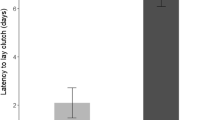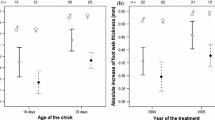Abstract
Although sibling competition in avian species has been extensively studied, the proximate mechanisms remain largely unknown. Recent research proposed that steroid hormones, in particular testosterone (T) and corticosterone (CORT), might play a role either in promoting competitive behavioral displays or in response to chronic nutritional stress accompanied by a sustained competitive situation. Here, we examine body condition, endogenous T levels and fecal glucocorticoid metabolites (FGM) as non-invasive measures of CORT in sibling broods of wild common tern chicks (Sterna hirundo) during three post-natal developmental stages. In this species, distinct within-brood size asymmetries are imposed by an asynchronous hatching interval, and sexes show slightly different growth patterns. First-hatched (a-)chicks were in better condition than their later-hatched sibling (b-chick). FGM levels inversely covaried with condition and were elevated at the end of pre-fledging development. T levels of a- and b-chicks changed with age, although the direction of the changes differed, with b-chicks eventually having higher levels than their older siblings. Survival to fledging was not associated with FGM but with T levels, which tended to be higher in surviving chicks. Our results are discussed with regard to how plasticity in steroid hormones could be involved in mediating sibling competition in common terns.


Similar content being viewed by others
References
Adkins-Regan E (2005) Hormones and animal social behavior. Princeton University Press, Princeton
Becker PH, Ludwigs J-D (2004) Sterna hirundo Common Tern. BWP Update (Birds West Palearct) 6:91–137
Becker PH, Wendeln H (1997) A new application for transponders in population ecology of the common tern. Condor 99:534–538
Becker PH, Wink M (2003) Influences of sex, sex composition of brood and hatching order on mass growth in common terns Sterna hirundo. Behav Ecol Sociobiol 54:136–146
Becker PH, Wendeln H, González-Solís J (2001) Population dynamics, recruitment, individual quality and reproductive strategies in common terns Sterna hirundo marked with transponders. Ardea 89:241–251
Blas J, Baos R, Bortolotti GR, Marchant TA, Hiraldo F (2006) Age-related variation in the adrenocortical response to stress in nestling white storks (Ciconia ciconia) supports the developmental hypothesis. Gen Comp Endocrinol 148:172–180
Blas J, Bortolotti GR, Tella JL, Baos R, Marchant TA (2007) Stress response during development predicts fitness in a wild, long lived vertebrate. Proc Natl Acad Sci USA 104:8880–8884
Bollinger PB (1994) Relative effects of hatching order, egg-size variation, and parental quality on chick survival in common terns. Auk 111:263–273
Bollinger PB, Bollinger EK, Malecki RA (1990) Tests of three hypotheses of hatching asynchrony in the common tern. Auk 107:696–706
Bonisoli-Alquati A, Boncoraglio G, Caprioli M, Saino, N (2011) Birth order, individual sex and sex of competitors determine the outcome of conflict among siblings over parental care. Proc R Soc B 278:1273–1279
Braasch A, Schauroth C, Becker PH (2009) Post-fledging body mass as a determinant of subadult survival in common terns Sterna hirundo. J Ornithol 150:401–407
Buchanan KL, Evan MR, Goldsmith AR, Bryant DM, Rowe LV (2001) Testosterone influences basal metabolic rate in male house sparrows: a new cost of dominance signalling? Proc R Soc B 268:1337–1344
Clark AB, Wilson DS (1981) Avian breeding adaptations: hatching asynchrony, brood reduction, and nest failure. Q Rev Biol 56:253–271
Dehnhard M, Schreer A, Krone O, Jewgenow K, Krause M, Grossmann R (2003) Measurement of plasma corticosterone and fecal glucocorticoid metabolites in the chicken (Gallus domesticus), the great cormorant (Phalacrocorax carbo), and the goshawk (Accipiter gentilis). Gen Comp Endocrinol 131:345–352
Eraud C, Trouvé C, Dano S, Chastel O, Faivre B (2008) Competition for resources modulates cell-mediated immunity and stress hormone level in nestling collared doves (Streptopelia decaocto). Gen Comp Endocrinol 155:542–551
Fargallo JA, Martínez-Padilla J, Toledano-Díaz A, Santiago-Moreno J, Dávila JA (2007) Sex and testosterone effects on growth, immunity and melanin coloration of nestling Eurasian kestrels. J Anim Ecol 76:201–209
Ferree ED, Wikelski MC, Anderson DJ (2004) Hormonal correlates of siblicide in Nazca boobies: support for the Challenge Hypothesis. Horm Behav 46:655–662
Folstad I, Karter AJ (1992) Parasites, bright males, and the immunocompetence handicap. Am Nat 139:603–622
Fridinger RW, O’Reilly KM, Kildaw SD, Buck CL (2007) Removal of a nest-mate elicits an age-dependent increase in plasma corticosterone of nestling black-legged kittiwakes. J Field Ornithol 78:93–99
Gil D, Bulmer E, Celis P, Puerta M (2008) Increased sibling competition does not increase testosterone or corticosterone levels in nestlings of the spotless starling (Sturnus unicolor). Horm Behav 54:238–243
González-Solís J, Becker PH, Wendeln H, Wink M (2005) Hatching sex ratio and sex specific chick mortality in common terns Sterna hirundo. J Ornithol 146:235–243
Goodship NM, Buchanan KL (2006) Nestling testosterone is associated with begging behaviour and fledging success in the pied flycatcher, Ficedula hypoleuca. Proc R Soc B 273:71–76
Goodship NM, Buchanan KL (2007) Nestling testosterone controls begging behaviour in the pied flycatcher, Ficedula hypoleuca. Horm Behav 52:454–460
Groothuis TGG, Meeuwissen G (1992) The influence of testosterone on the development and fixation of the form of displays in two age classes of young black-headed gulls. Anim Behav 43:189–208
Groothuis TGG, Ros AF (2005) The hormonal control of begging and early aggressive behavior: experiments in black-headed gull chicks. Horm Behav 48:207–215
Hahn DC (1981) Asynchronous hatching in the laughing gull: cutting losses and reducing rivalry. Anim Behav 29:421–427
Hoppen H-O, Niederstucke H (2008) Ultra sensitive steroid radioimmunoassays for the diagnosis of equine gonadal dysfunction. Pferdeheilkunde 24:5–9
Hull KL, Cockrem JF, Bridges JP, Candy EJ, Davidson CM (2007) Effects of corticosterone treatment on growth, development, and the corticosterone response to handling in young Japanese quail (Coturnix coturnix japonica). Comp Biochem Physiol A 148:531–543
Kahn NW, John JS, Quinn TW (1998) Chromosome-specific intron size differences in the avian CHD gene provide an efficient method for sex identification in birds. Auk 115:1074–1078
Kitaysky AS, Wingfield JC, Piatt JF (2001) Corticosterone facilitates begging and affects resource allocation in the black-legged kittiwake. Behav Ecol 12:619–625
Kitaysky AS, Kitaiskaia EV, Piatt JF, Wingfield JC (2003) Benefits and costs of increased levels of corticosterone in seabird chicks. Horm Behav 43:140–149
Klaassen M, Zwaan B, Heslenfeld P, Lucas P, Luijckx B (1992) Growth-rate associated changes in the energy-requirements of tern chicks. Ardea 80:19–28
Krackow S, Tkadlec E (2001) Analysis of brood sex ratios: implications of offspring clustering. Behav Ecol Sociobiol 50:293–301
Langham NPE (1972) Chick survival in terns (Sterna Spp.) with particular reference to the common tern. J Anim Ecol 41:385–395
Lobato E, Merino S, Moreno J, Morales J, Tomás G, Martínez-de la Puente J, Osorno J, Kuchar A, Möstl E (2008) Corticosterone metabolites in blue tit and pied flycatcher droppings: effects of brood size, ectoparasites and temperature. Horm Behav 53:295–305
López-Rull I, Celis P, Salaberria C, Puerta M, Gil D (2011) Post-fledging recruitment in relation to nestling plasma testosterone and immunocompetence in the spotless starling. Funct Ecol 25:500–508
Love OP, Bird DM, Shutt LJ (2003) Corticosterone levels during post-natal development in captive American kestrels (Falco sparverius). Gen Comp Endocrinol 130:135–141
Martin LB (2009) Stress and immunity in wild vertebrates: timing is everything. Gen Comp Endocrinol 163:70–76
Martin LB, Gilliam J, Han P, Lee K, Wikelski M (2005) Corticosterone suppresses cutaneous immune function in temperate but not tropical house sparrows, Passer domesticus. Gen Comp Endocrinol 140:126–135
Millspaugh JJ, Washburn BE (2004) Use of fecal glucocorticoid metabolite measures in conservation biology research: considerations for application and interpretation. Gen Comp Endocrinol 138:189–199
Mlody B, Becker PH (1991) Körpermasse-Entwicklung und Mortalität von Küken der Flußseeschwalbe (Sterna hirundo) unter ungünstigen Umweltbedingungen. Vogelwarte 36:110–131
Mock DW, Parker GA (1997) The evolution of sibling rivalry. Oxford University Press, New York
Möstl E, Palme R (2002) Hormones as indicators of stress. Domest Anim Endocrinol 23:67–74
Möstl E, Maggs JL, Schrötter G, Besenfelder U, Palme R (2002) Measurement of cortisol metabolites in faeces of ruminants. Vet Res Commun 26:127–139
Möstl E, Rettenbacher S, Palme R (2005) Measurement of corticosterone metabolites in birds’ droppings: an analytical approach. Ann NY Acad Sci 1046:17–34
Naguib M, Riebel K, Marzal A, Gil D (2004) Nestling immunocompetence and testosterone covary with brood size in a songbird. Proc R Soc B 271:833–838
Nisbet ICT, Cohen ME (1975) Asynchronous hatching in common and roseate terns, Sterna hirundo and S. dougallii. Ibis 117:374–379
Núñez-de la Mora A, Drummond H, Wingfield JC (1996) Hormonal correlates of dominance and starvation-induced aggression in chicks of the blue-footed booby. Ethology 102:748–761
Oddie KR (2000) Size matters: competition between male and female great tit offspring. J Anim Ecol 69:903–912
Pérez-Rodríguez L, Blas J, Viñuela J, Marchant TA, Bortolotti GR (2006) Condition and androgen levels: are condition-dependent and testosterone-mediated traits two sides of the same coin? Anim Behav 72:97–103
Quillfeldt P, Möstl E (2003) Resource allocation in Wilson’s storm-petrels Oceanites oceanicus determined by measurement of glucocorticoid excretion. Acta Ethol 5:115–122
Quillfeldt P, Masello JF, Strange IJ, Buchanan KL (2006) Begging and provisioning of thin-billed prions, Pachyptila belcheri, are related to testosterone and corticosterone. Anim Behav 71:1359–1369
Rettenbacher S, Möstl E, Hackl R, Ghareeb K, Palme R (2004) Measurement of corticosterone metabolites in chicken droppings. Br Poult Sci 45:704–711
Roberts ML, Buchanan KL, Evans MR (2004) Testing the immunocompetence handicap hypothesis: a review of the evidence. Anim Behav 68:227–239
Ros AFH (1999) Effects of testosterone on growth, plumage pigmentation, and mortality in black-headed gull chicks. Ibis 141:451–459
Ros AFH (2008) Patterns of testosterone responsiveness and immunity in relation to competitive behavior in chicks. Horm Behav 54:234–237
Ros AFH, Dieleman SJ, Groothuis TGG (2002) Social stimuli, testosterone, and aggression in gull chicks: support for the challenge hypothesis. Horm Behav 41:334–342
Schwabl H (1999) Developmental changes and among-sibling variation of corticosterone levels in an altricial avian species. Gen Comp Endocrinol 116:403–408
Smith T, Leonard M, Smith B (2005) Provisioning rules and chick competition in asynchronously hatching common terns (Sterna hirundo). Behav Ecol Sociobiol 58:456–465
Sockman KW, Schwabl H (2001) Plasma corticosterone in nestling American kestrels: effects of age, handling stress, yolk androgens, and body condition. Gen Comp Endocrinol 122:205–212
Stienen EWM, Brenninkmeijer A (2002) Variation in growth in sandwich tern chicks Sterna sandvicensis and the consequences for pre- and post-fledging mortality. Ibis 144:567–576
Stoleson SH, Beissinger SR (1995) Hatching asynchrony and the onset of incubation in birds, revisited: when is the critical period? In: Power DM (ed) Current Ornithology. Plenum Press, New York, pp 191–270
Tarlow EM, Wikelski M, Anderson DJ (2001) Hormonal correlates of siblicide in Galápagos Nazca boobies. Horm Behav 40:14–20
Tempel DJ, Gutiérrez RJ (2004) Factors related to fecal corticosterone levels in California spotted owls: implications for assessing chronic stress. Conserv Biol 18:538–547
Uller T (2006) Sex-specific sibling interactions and offspring fitness in vertebrates: patterns and implications for maternal sex ratios. Biol Rev 81:207–217
Verboven N, Monaghan P, Evans DM, Schwabl H, Evans N, Whitelaw C, Nager RG (2003) Maternal condition, yolk androgens and offspring performance: a supplemental feeding experiment in the lesser black-backed gull (Larus fuscus). Proc R Soc B 270:2223–2232
Wagener M (1998) Praktische Hinweise für brutbiologische Untersuchungen an der Flußseeschwalbe Sterna hirundo. Die Vogelwelt 119:279–286
Wingfield JC, Hegner RE, Dufty AM Jr, Ball GF (1990) The “Challenge Hypothesis”: theoretical implications for patterns of testosterone secretion, mating systems, and breeding strategies. Am Nat 136:829–846
Acknowledgments
This study would not have been possible without the help of numerous people during field work, especially C. Bauch, J. Riechert, J. Sprenger, L. Schmidt and G. Wagenknecht. We are obliged to R. Nagel and J. Trauernicht for technical assistance and H. Niederstucke for help with testosterone assays. We thank L. Szostek for checking the English. F. Bairlein and two anonymous referees provided useful comments on an earlier draft of the manuscript. Field work was carried out under license of the Conservation Board Wilhelmshaven “Untere Naturschutzbehörde, Wilhelmshaven” and LAVES, Oldenburg, and complied with the current laws of the country. The study was financially supported by the German Research Association Deutsche Forschungsgemeinschaft (BE 916/8).
Author information
Authors and Affiliations
Corresponding author
Rights and permissions
About this article
Cite this article
Braasch, A., Palme, R., Hoppen, HO. et al. Body condition, hormonal correlates and consequences for survival in common tern chicks. J Comp Physiol A 197, 1009–1020 (2011). https://doi.org/10.1007/s00359-011-0663-4
Received:
Revised:
Accepted:
Published:
Issue Date:
DOI: https://doi.org/10.1007/s00359-011-0663-4




